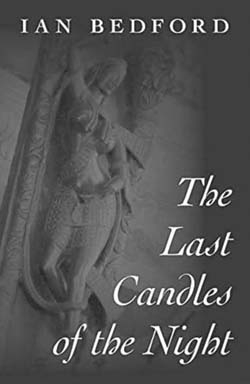The Last Candles of the Night is the fourth and last novel by Ian Bedford, who passed away, at the age of 76, shortly after the novel was published. He must have been a remarkable man. He did his Master’s in Lahore, studied Islam in Pakistan and India, did much field research work in India, Pakistan and elsewhere in Central Asia, translated Urdu poetry, explored Sufism and Indian classical music, and married an Indian woman. And yes, he worked in the Department of Anthropology at Macquarie University for decades before taking to writing fiction. All his novels—his earlier novels are The Shell of the Old (1981); A View from the Bund (1990) republished recently; and The Resemblance (2008)—are of interest to Indian readers because they reflect this unusual background. The intriguing title of his last novel is also taken from a sher by an Indian poet, well, actually an Indo-Pakistani poet, for the poet, Zaheer Kashmiri, chose to live in Pakistan after the Partition (like his contemporary and fellow-Leftist, Faiz Ahmed Faiz.) Incidentally, the complete sher consists of two lines: Hamen khabar hai ke ham hain chirag-e-aakhire-shab Hamare baad andhera nahin ujaala hai (We know that we are the last flicker of the flame After us will come not darkness but light.)
Of course, the meaning of the sher alters if you read only the first line of it, as the author has chosen to do. But obviously he has done it purposely, wanting (unlike the poet) to lament the dying of some flame, not to herald the coming dawn. The question is, what flame? But first, the ‘story’ of the novel . . .
It begins in the year 2001, shortly before 9/11, in Sydney, Australia, where an elderly Philip Chalk, back from a 50 year, selfimposed exile managing schools in India, is struggling to cope with a retired life—and ‘home’. It is not an easy task, for nobody there has much use for him, not the (educational) system, no matter what his achievements in India, nor any near or dear one (except a grandson curious about his Indian past) and certainly not his Indian wife Jenny, whom he had married in India back in 1948, brought to Australia shortly thereafter, and soon abandoned for fifty years, yes, fifty long years, save for three brief visits in all those years. An improbable tale? Of course. But interesting. And, come to think of it, an Indian wife, once married, stays married, no matter what, or where!
Equally interesting (and definitely probable) is the Indian part of the story, about a love triangle featuring a young Philip working as a teacher/headmaster in the princely state of Hyderabad in the twilight months after Indian Independence and before the State’s accession to the Indian union. The other two sides of the triangle are made up of Ragini, a beautiful Communist revolutionary, and Anand, a secret agent of the Indian National Congress. Tension in the narrative is provided by Philip’s repentance for what he did (or did not do) to the other two (because all is fair in love?) The years 1948 and 2001 are sought to be linked by, first, Jenny’s past (in a twist reminiscent of James Hilton’s famous 1930s novel Random Harvest) and second, by comparing the Communist armed struggle in Hyderabad in 1948 with the ‘boat people’ crisis in Australia in 2001.

